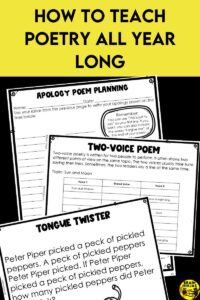
Many teachers add a poetry unit to their Language Arts programming, but what if you teach poetry throughout the school year? It’s not as hard as it sounds and you don’t even have to be a poetry expert.
Poetry is a beautiful and expressive form of literature that allows students to explore language, imagery, and emotions in creative ways. Many students enjoy poetry because it’s short and the rhyming is catchy. Come learn some of the ways we teach poetry throughout the school year.
Teach Poetry
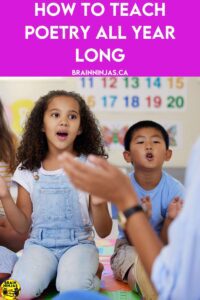
Students who struggle with poetry do so because they don’t understand how to read it or understand how it works. Poetry is filled with different poetic devices and symbolism and has many forms.
We teach many of these poem lessons using drama. Students learn about different aspects of poetry and then act them out. You can find the Poetry Through Drama lessons in our TpT Store ($USD) or our BN Shop ($CAN).
Punctuation
Start by teaching students how to read basic poetry. Explain that the punctuation dictates where the reader pauses or stops, but that doesn’t always mean the pause comes at the end of the line. Explain that authors will use punctuation to help emphasize different words or phrases. Find a few short poems and practice reading them aloud. A familiar poem students might know is “In Flanders Fields” by John McCrae.
Poetic Devices
Even though figurative language is common in poetry, it can be found in many other forms of literature. When you teach poetry, don’t assume students understand the different poetic devices.
Imagery
Poets use imagery to create vivid mental pictures by appealing to the senses of sight, sound, taste, touch, and smell. Encourage students to identify sensory details and descriptive language in poems to visualize the poet’s message.
Metaphor and Similes
Metaphors and similes are figurative language techniques used to make comparisons between two unlike things. Help students distinguish between metaphors (direct comparisons) and similes (comparisons using “like” or “as”) in poetry.
Rhyme and Rhythm
Rhyme and rhythm contribute to the musicality and flow of a poem. Explore different types of rhyme schemes (e.g., AABB, ABAB) and meter (e.g., iambic pentameter) with students to analyze the structure and sound patterns of poems.
Use nursery rhymes to identify rhyming patterns. Teach students how to use a rhyming dictionary if they struggle with thinking of rhyming words.
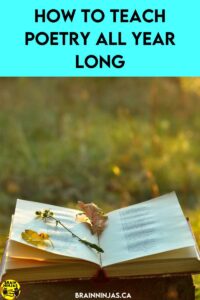
Symbolism
Symbolism involves using objects, images, or actions to represent abstract ideas or concepts. Guide students in identifying symbolic elements in poetry and interpreting their deeper meanings and significance.
Start by talking about symbols that students know and understand. Use logos from stores or games. Talk about how people can communicate with symbols. Explain some of the different symbols that can be used in texts.
Personification
Personification gives inanimate objects human (or animal) qualities. For example, the tree reached its arms up in the air and tried to hug the Sun. Students often enjoy making sentences to personify different objects in the classroom.
Forms of Poetry
Free Verse
Free verse poetry does not adhere to a specific rhyme scheme or meter, allowing poets greater flexibility and freedom in their expression. Encourage students to experiment with free verse poetry by writing poems based on their own thoughts, feelings, and observations.
Haiku
Haiku is a traditional Japanese form of poetry consisting of three lines with a syllable pattern of 5-7-5. Introduce students to the beauty and simplicity of haiku by writing and sharing their own haiku poems inspired by nature or everyday experiences. This is often an easy form for students to read and write because it’s short and sweet.
Acrostic
Acrostic poems feature words or phrases spelled vertically down the page, with each letter serving as the beginning of a line in the poem. Encourage students to create acrostic poems using their names, favourite words, or thematic concepts related to classroom topics.
Limerick
Limericks are humorous poems consisting of five lines with a specific rhyme scheme (AABBA) and a distinctive rhythm. Have fun with students by writing silly limericks together. Explore wordplay and rhyme. Your students will likely find dirty ones if they are left searching online. Instead, use some of the limericks from this site to model reading.
Nonsense
Lewis Carroll wrote Jabberwocky, a poem full of nonsense words. We created a lesson plan around the poem and use it every year with our students in Grades 4 and 5. We read the poem with students and talk about how we know where to pause or stop (based on the punctuation) and how to read it (even though these aren’t English words). Students also get to write their own poems.
This is such a fun way to teach poetry, and students love it. We’ll send this poetry lesson directly to your inbox when you sign up for our email list. If you’re already on the list, you can find the poetry lesson in our Resource Library.
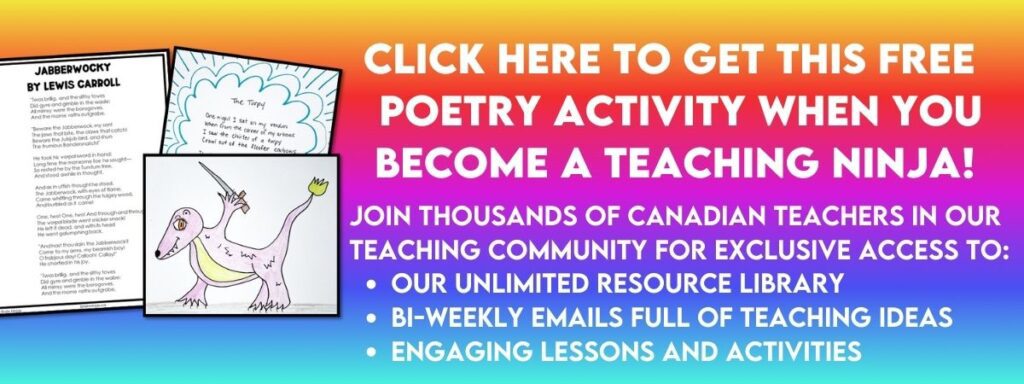
Found Poetry
Engage students in found poetry activities by using newspapers, magazines, or other texts as source materials for creating poems. Encourage students to select words or phrases from the text and arrange them in creative ways to convey a new message or theme.
If you are looking for some simple Poetry Writing Prompts, we put together this set that can be printed or used digitally. Students do not need to be poetry experts to use the prompts. Find our Poetry Writing Prompts in our TpT Store ($USD) or our BN Shop ($CAN).
Include Poetry Books in Your Read-Alouds
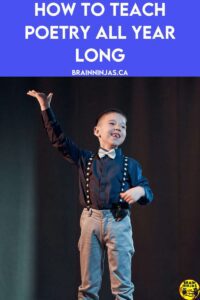
Who says that read-alouds can only be picture books or chapter books? Poetry books can be a fun way to add a little poetry to your day. You don’t have to make it a formal lesson, but if you’re looking for ways to make the most of your time reading aloud, check out this post: 15 Ways to Engage Readers During Your Read-Aloud.
Some of our Favourite Poetry Books
We don’t include links to books as we prefer for people to support local bookstores. Many will order any book you want and your money stays in the community where you live.
- “Love That Dog” by Sharon Creech: This novel in verse follows a young boy named Jack as he discovers his love for poetry through the guidance of his teacher. The book features poems by famous poets such as William Carlos Williams and Walter Dean Myers, making it an excellent introduction to poetry for young readers. She also has the book “Hate That Cat,” which makes a great follow-up.
- “Out of Wonder: Poems Celebrating Poets” by Kwame Alexander: This collection of original poems pays tribute to twenty influential poets from diverse backgrounds and time periods. Each poem celebrates the unique style and contributions of a different poet, inspiring readers to explore the power of poetry in their own lives. He also has a book called “The Crossover.”
- “A Pizza the Size of the Sun” by Jack Prelutsky: Jack Prelutsky’s playful and imaginative poems delight readers with their humour, wit, and wordplay. This collection features a wide range of poems on topics such as animals, food, and everyday experiences, making it accessible and engaging for young readers.
- Robot, Unicorn, Queen: Poems for You and Me by Shannon Bramer: These are shorter poems in a variety of forms that are all about childhood. Your students may find lots to connect with.

Don’t Forget About Poetry Month
The League of Canadian Poets established National Poetry Month every April in 1998. Canadians from coast to coast to coast celebrate poetry in Canadian culture. You can visit their website.
Poem in Your Pocket Day is held in April. Carry a poem in your pocket. Ask others to share their poem. For more information, check out this blog post: How to Celebrate Poem in Your Pocket Day.
How do you teach poetry in your classroom all year? We’d love to hear more. Tell us about it in the comments below.






